This book is a collection of photographs of the railway scene in the 1980s, with many featuring locations and infrastructure that, like the locomotives themselves, have gone forever.
Published in February 2023 by Amberley Publishing and written by Andrew Walker and Vaughan Hellan, this soft cover book measures around 23.4 cm x 16.5 cm, and has 96 pages and 180 illustrations. It has a published price of £15.99 although Amberley Publishing currently has it on offer at £14.39, and at the time of writing, it can be obtained from Amazon for £12.17.
Many photographs in the book will bring back memories for railway enthusiasts who were around in the 1980s. We thought everyday sights such as freight trains on the Woodhead route and Deltic-hauled expresses on the East Coast Main Line would last forever.
First-generation diesel multiple units, freight trains before the widespread use of merry-go-round trains, and newly-opened marshalling yards that became redundant soon after their opening will invoke nostalgia for those who remember the era.
On the East Coast Main Line, the archetypal motive power until the early 1980s were the Deltics that replaced LNER Pacifics on the King’s Cross to Edinburgh Waverley expresses. Four examples are seen below, with D9000 Royal Scots Grey at the top left looking resplendent after a repaint into its original livery in 1986, whilst at the bottom left its classmate 55015 Tulyar looks rather shabby after being rescued from scrap for preservation in 1982. During their later years, they ventured away from the East Coast, as with 55004 Queens Own Highlander pictured at Huddersfield at the top right.
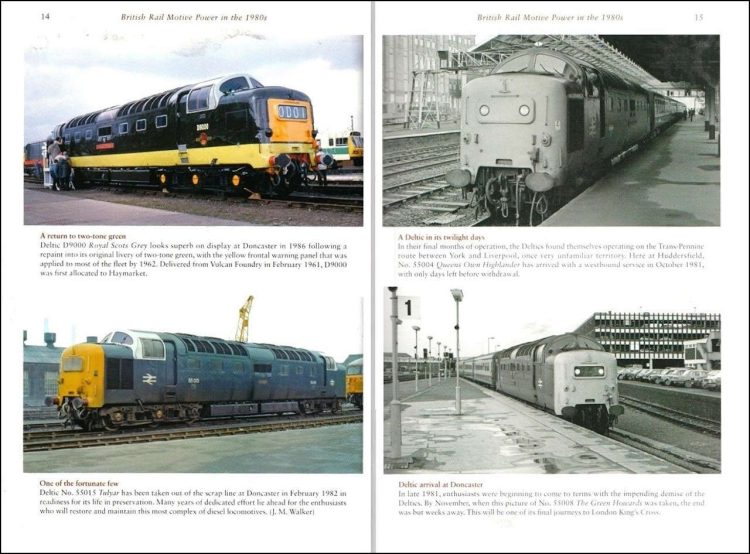
The 1980s saw the gradual replacement of the original 25kV electric locomotives on the West Coast main line by Class 90s. At the top left, 81008 still has four more years of service left before it meets its fate with the scrap man.
In comparison, at the bottom right is 89001 Avocet, built as a prototype for the Class 91s that replaced the Deltics on the East Coast Main Line. During the decade, there was still much variety to be seen on freight services, such as Class 56 No. 56111 at the top right on a block train of phosphoric acid tanks, whilst privately-owned locomotives began to show their presence, spearheaded by Foster Yeoman from its quarries at Merehead in Somerset as seen at the bottom right with Class 59 No. 59002.
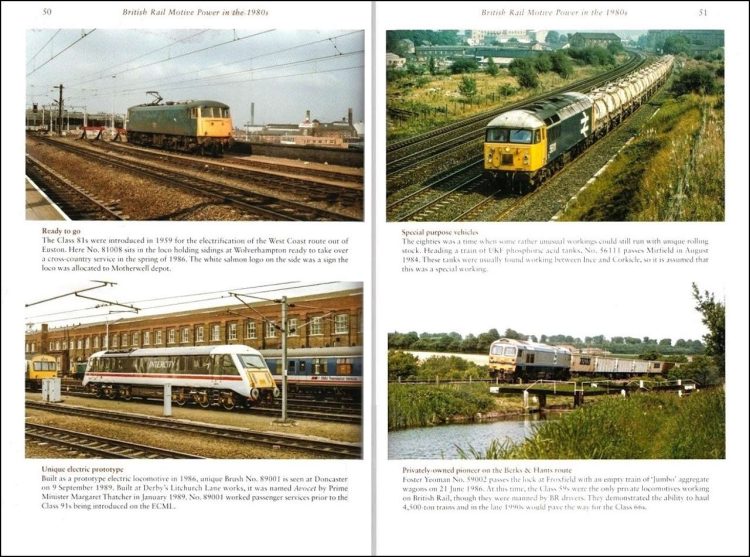
To adopt Henry Ford’s phrase of you can have any colour as long as it’s black, in the 1980s, rail blue was the all-encompassing livery for locomotives and rolling stock. The images on the left give a good appreciation of how the livery presented a uniform look, whilst on the right are two Class 25 locos with the ‘double-arrow’ logos that was the industry standard.
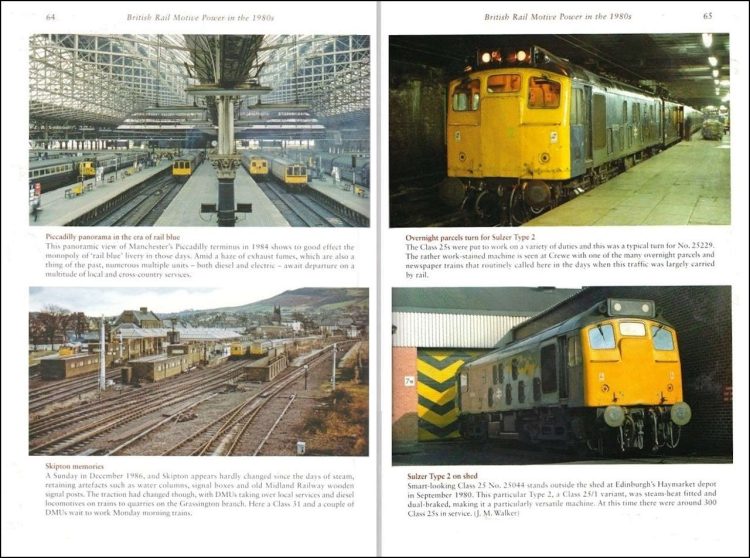
During the 1980s there was still a hangover from steam days, when engine sheds that formerly housed many dozens of steam locomotives became home for seemingly endless lines of diesel locomotives, such as Crewe at the top left and Cardiff Canton at the bottom left. In contrast, with dieselisation, Colchester did not have its own allocation of locomotives. However, its former shed still served its purpose by playing host to visiting locomotives, as seen at the top right.
At that time, Toton shed in the East Midlands was paradise for railway enthusiasts, as it was home to scores of diesel locomotives, making sights such as at the bottom right an everyday occurrence.
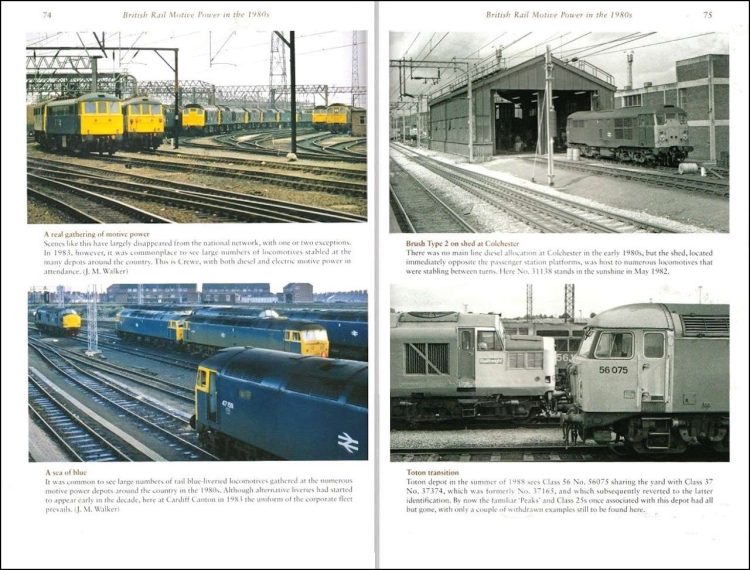
One inexplicable victim of closures in the 1980s was the Woodhead route between Manchester and Sheffield route, together with the Class 76s that exclusively worked on the route. The photos below show pairs of 76s heading westbound out of Woodhead Tunnel just four days before the line’s closure. On the right is the first page of a very informative Appendix that lists the numbers of locomotives of each class at the beginning and end of the 1980s, providing an easy comparison of changes during the decade.
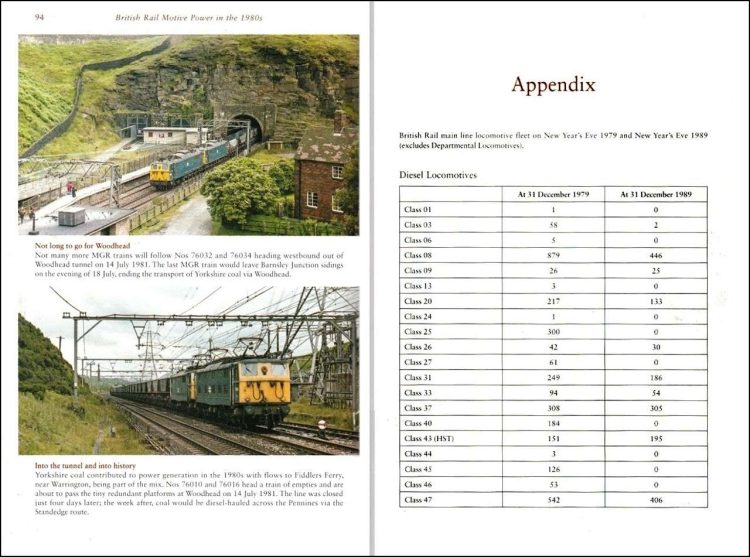
The contents bring back many familiar scenes to whose who were around in the 1980s, such as trainspotters scrambling around locomotive works, diversions on the Settle and Carlisle route, engines being scrapped, vast engine sheds, and everyday scenes of the railways, like a mail bag on a platform waiting for its train.
Most classes of locomotives that ran in the decade are illustrated and shown to good effect in their natural settings across the country from Exeter to Scotland. Photographic composition is mostly excellent, in many cases illustrating trains as part of the landscape rather than close-up shots of just the locomotive.
A minor criticism is that there is no Contents List. Each caption is prefixed by a very brief heading, which would have been easy to list in an index. With no sub-sections, the book has no meaningful structure for referring back to images of interest.
Many of the scenes will be familiar to those fortunate enough to remember the 1980s or will show those who don’t what variety there was to be seen during those years, with the quality of the photos doing justice to the authors’ efforts. This book is recommended for anyone who remembers or wants to learn more about the 1980s railway scene.
The book is available to purchase from Amazon and from Amberley Publishing.
We would like to thank Amberley Publishing for providing us with a copy of the book for review.






Responses